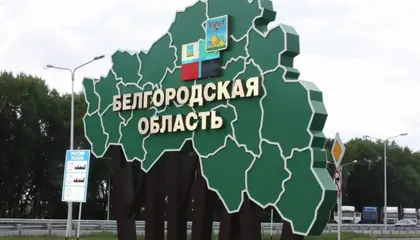Two high-profile Russian opinion formers, who are not normally in public agreement – one a hard-core critic of Moscow’s military leadership and the other a key regional official directly appointed by President Vladimir Putin – joined in criticism of official statements on Wednesday. They not only criticized the Kremlin’s claims, but directly contradicted the official narrative that Russian forces had decisively repelled the recent border incursions and that peace and calm now prevailed in Russia’s western Belgorod region.
Vyacheslav Gladkov, governor of the Belgorod Oblast, the west Russian territory raided by several dozen armed men from Ukraine on Monday, in a Wednesday morning statement contradicted Moscow’s claims that three villages lost to insurgents had returned to government control, saying that some localities remain in “enemy” hands.
JOIN US ON TELEGRAM
Follow our coverage of the war on the @Kyivpost_official.
Russia’s defense ministry, on Tuesday, declared its troops had “completely eliminated” the invasion force that had broken into the Belgorod border region and that during “the course of the counter-terrorist operation, the nationalist formations were blocked and destroyed by air strikes and artillery fire.”
“There are villages in the Grayvoron region (in Belgorod Oblast) that have not been cleared of the enemy,” Gladkov said in a video statement.

Russia Claims Capture of Two More East Ukraine Villages
Igor Girkin, a high-profile critic of Russia’s national military leadership, in his own Wednesday morning comments, likewise questioned official Kremlin claims the Belgorod border incursion was completely over. He stated that, while Russian troops had recaptured the settlements taken over by the insurgents, “enemy fighters” were still at large.
“Insurgents” and members of the Ukrainian ‘Kraken’ special operations group were still operating in Belgorod border regions, Girkin said, citing local sources. He went on to claim that Ukrainians and “anti-Russian government fighters” had taken to the woods and unoccupied buildings, and were currently mining “all road intersections with a new type of landmine.”
More than 550 residents of the Grayvoron region were still unable to reach their homes, on Wednesday, because of ongoing combat in their villages or damaged homes, and were living in state-provided housing, Gladkov said. Ongoing fighting had damaged a gas pipeline in the Grayvoron region, he added.
Some independent news sources, on Wednesday, likewise reported that official Russian claims of the complete destruction of raider formations were exaggerated. Images published by Ukraine’s UNIAN news agency showed soldiers, identified as members of the Russian Volunteer Corps, at a base in a wooded area, along with two HEMMIT mine-proof vehicles and, what appeared to be, a captured Russian BTR-82A armored personnel carrier.
Launched on Monday, the border incursion according to independent Ukrainian news reports was organized and executed by two groups of Russian nationals, called the Freedom of Russia Legion and the Russian Volunteer Corps. The Ukrainian national government – perhaps tongue in cheek – denied it had anything to do with the raid. The attackers overwhelmed a border checkpoint and walked freely into, at least, three villages, before significant numbers of Russian troops reached the scene.
The border attack was paralleled, Russian officials said, with firing, elsewhere on the border, from Ukraine. Shortly after midnight on Wednesday morning, Gladkov’s personal Telegram channel reported Ukrainian drone strikes in Novaya Tavolzhanka and Tomorovka - Belgorod Oblast towns respectively three and 27 kilometers away from the Russia-Ukraine frontier. Grenades dropped from drones damaged cars, blew holes in roofs and broke windows, he said. “Ukrainian combatants” also shelled the border village of Terezovka, some 120 kilometers to the east, the statement said.
Russian officials responsible for defending the country and protecting Russian citizens from raids, shell fire and grenades delivered by drone have a lot to answer for, Gladkov said in his video statement.
“As the governor I can’t leave the question unasked: we’ve had combat activity now for a year and half … and the authorities have always said ‘everything is under control’. We’ve built fortifications, and yet the enemy is able to drive into our regional centers basically, on tanks, bypassing three villages and anti-tank barriers. Why is our border so full of holes?” Gladkov said.
“Isn’t there any way we can ask our security officials and Ministry of Defense why everything is so bad?” he asked. “Why did all of this happen? I’m sure state investigators will find out. But me personally, I have a lot of questions I want to ask the Defense Ministry.”
Girkin said the incursion was successful, in no small part, because top defense ministry officials have failed for months take the threat of cross-border attacks seriously. The raiders attacked a Russian border troops’ unit made up mostly of conscripts and lacking in transport, fortification materials and anti-tank weapons, he said, so that Ukrainian army tanks, firing from the Ukrainian side of the border, were able to bombard the checkpoint with impunity.
Girkin is a former field commander of infantry units mobilized to invade Ukraine’s Donbas region in 2014. He fell out with other leaders participating in the invasion, and is wanted for his role in the shootdown of the MH17 airliner. Since Russia’s Feb. 2022 invasion of Ukraine, he has been a vociferous critic of Russia’s national leadership and its conduct of the war.
Local authorities in Belgorod learned nothing from the border incursion, Girkin said, highlighting how quickly a temporary martial law order in the border regions had been cancelled, within hours of the central government declaring the territory “cleared of invaders.”
You can also highlight the text and press Ctrl + Enter






